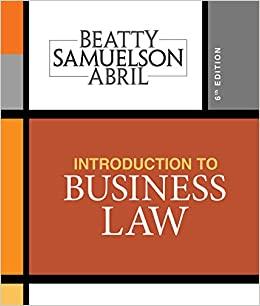Question
Please assist and provide Excel sheet as attachment, thank you. 1.Your company utilizes both employees (L) and specialized robots (R) in its production process. The
Please assist and provide Excel sheet as attachment, thank you.
1.Your company utilizes both employees (L) and specialized robots (R) in its production process. The hourly wage of employees is $18, and the hourly cost of operating a robot is $220. The table below describes how the number of each type of input affects output or product (in a marginal way).
Number of employees (L) Marginal product of labor (MPL) Number of robots (R) Marginal product of robots (MPR)
1 39.6 1 440
2 36.0 2 418
3 32.4 3 396
4 28.8 4 374
5 25.2 5 352
6 21.6 6 330
7 18.0 7 308
a.Given the much higher productivity of robots, why would the company ever consider using employees at all in its production?
b.When it started out, the company used five employees and two robots; is this an ideal combination of inputs? Why or why not?
c.During its slow season, the company reduces its employees to three; what would be the optimal number of robots to use in this situation?
d.During the normal season when the company uses five robots, what would be the optimal number of employees to use?
2.Your company has estimated its total cost to be TC = 46,000 + 15Q + 0.006Q2; its marginal cost is thus MC = 15 + 0.012Q, where Q is the quantity of units produced and TC is in dollars. Since your market is relatively competitive, your company is able to sell its output for $93 each (which thus yields MR = 93 and TR = 93Q).
a.Produce a chart in Excel showing TC and TR with Q on the horizontal axis. Have Q go from 0 to 10,000 units (each row of your Q column can increase by a relatively large number so that your table isn't huge). Produce a second chart showing MC and MR with Q again on the horizontal axis.
b.What is the optimal level of output for your company to produce/sell? What is the marginal revenue from the last unit sold?
c.What are the total revenue, total cost, and profit (net benefit/net revenue/etc.) from selling the optimal number of units?
d.An eager intern at your company suggests that, since the company earns $93 revenue for each unit sold, then the company could make still more profit by selling more than the level chosen in part b; why would your company not want to produce and sell more output than the level you chose in part b?
3.You work for The Bee Sneeze, a company that produces organic, free range, gluten-free honey ("Our Bee Nose What's Good!"). You've collected data on monthly sales (S, number of jars of honey sold per month) the price of your jar of honey (P, in dollars), and the population size in the different cities in which your company has retail locations (N, number of people; you currently only have one establishment in each city). You estimate the following regression model: S = a + bP + cN. In your regressions, you usually look for a 5%-or-better level of confidence.
a.What signs do you expect for a, b, and c?
b.Your regression yields the following results:
Adjusted R Square 0.619
Independent Variables Coefficients Standard Error t Stat P-value
Intercept 10313 2967 3.475 0.01775
P -379.67 131.77 -2.881 0.03453
N 0.0018 0.0060 0.307 0.77093
Interpret what these coefficients mean.
c.Does price have a statistically significant effect on sales?
d.Does population have a statistically significant effect on sales?
e.What portion of the total variation in sales remains unexplained?
f.The Bee Sneeze is considering selling in a new city, where the population is 187,500, and setting its jar of honey price at $13.50. What level of monthly sales would you expect in this new city (rounded to the nearest unit)?
4.Download the "State Crime" Excel sheet; row 2 gives detailed descriptions of each variable, while row 4 gives short versions that should be used in your regressions. Estimate the following multiple regression models (remember that all of your independent variables will have to be in adjacent columns in Excel). Look at each set of results critically and consider how you would interpret the strengths and weaknesses of each model. Save your results from each model for use when completing the end-of-module assessment. Use "PropCrime" as your dependent variable in each model. The notation f(X, Y, Z) means "a function of X, Y, Z; i.e., X, Y, and Z are your independent variables. Even though it isn't listed, each model will include an intercept. NOTE: when Excel reports a value like 2.4E-06, this is scientific notation for 2.4 * (10^-6), or 0.0000024.
Model A: PropCrime = f(PerCapIncome, %SameHouse, %young)
Model B: PropCrime = f(Robbery, %Unemploy, MedianAge)
Model C: PropCrime = f(Robbery, %Unemploy, MedAgeMale)
Model D: PropCrime = f(Robbery, %Unemploy, MedAgeFemale)
Model E: PropCrime = f(%Metro, %Bachelors+, %Poverty, Temp)
Model F: PropCrime = f(%Metro, %Bachelors+, %Poverty, Sun)
Model G: PropCrime = f(%Metro, %Bachelors+, %Poverty, Rain)
The state of East Maryland currently has a property crime rate of 1,896.8, a 91.4% metro rate (be sure to use 91.4% or 0.914, not 91.4; be careful of the units on all the variables), a "%Bachelors+" rate of 38.6%, a poverty rate of 9.6, and about 112 sunny days per year. Recent economic changes have led to the poverty rate declining to 9.1. This change will likely be associated with the PropCrime rate changing from about 1896.8 property crimes (per 100,000 inhabitants) to about ___ property crimes.
Step by Step Solution
There are 3 Steps involved in it
Step: 1

Get Instant Access to Expert-Tailored Solutions
See step-by-step solutions with expert insights and AI powered tools for academic success
Step: 2

Step: 3

Ace Your Homework with AI
Get the answers you need in no time with our AI-driven, step-by-step assistance
Get Started


